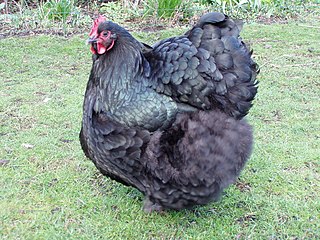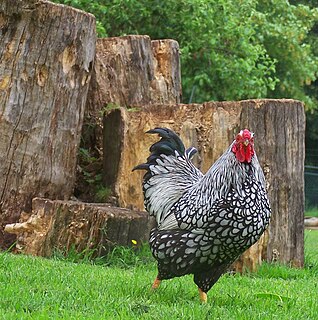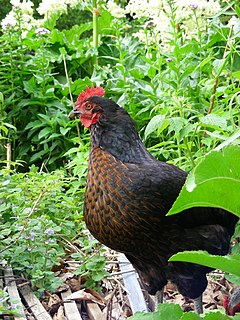
The Araucana is a breed of domestic chicken from Chile. Its name derives from the Araucanía region of Chile where it is believed to have originated. It lays blue-shelled eggs, one of very few breeds that do so.

The Orpington is a breed of chicken named after the town of Orpington, Kent, in south-east England. It was bred for superior egg laying while retaining meat quality. Its large size and soft appearance together with its rich colour and gentle contours give it an attractive appearance, and as such it is grown more often as a show bird rather than a utility breed. Hens often become broody and are good mothers. Although rather heavy, Orpingtons are able to fly small distances but rarely do so.

The Brahma is a large breed of chicken developed in the United States from birds imported from the Chinese port of Shanghai. The Brahma was the principal meat breed in the United States from the 1850s until about 1930.

The Sussex is a British breed of dual-purpose chicken, reared both for its meat and for its eggs. Eight colours are recognised for both standard-sized and bantam fowl. A breed association, the Sussex Breed Club, was organised in 1903.

The Plymouth Rock is an American breed of domestic chicken. It was first seen in Massachusetts in the nineteenth century, and for much of the early twentieth century was the most popular chicken breed in the United States. It is a dual-purpose breed, raised both for its meat and for its brown eggs. It is resistant to cold, easy to manage, and a good sitter.

The Dominique, also known as Dominicker or Pilgrim Fowl, is a breed of chicken originating in the United States during the colonial period. It is considered America's oldest breed of chicken, probably descending from chickens brought to New England from southern England during colonial times. By the 19th century, they were widely popular and were raised in many parts of the country. Dominiques are a dual purpose breed, being valued for their meat as well as for their brown eggs. They weigh 6 to 8 pounds at maturity. In earlier times, their feathers were much sought after as stuffing for pillows and mattresses.

The Wyandotte is an American breed of chicken developed in the 1870s. It was named for the indigenous Wyandot people of North America. The Wyandotte is a dual-purpose breed, kept for its brown eggs and its yellow-skinned meat. It is a popular show bird, and has many color variants. It was originally known as the American Sebright.

Sex-links are crossbred chickens whose color at hatching is differentiated by sex, thus making chick sexing an easier process. Sex-links come in several varieties. As hybrids of laying or dual-purpose breeds infused with extra vigor via heterosis, sex-links can be extremely good egg-layers which often produce 300 eggs a year or more depending on the quality of care and feed. The color of their eggs vary according to the mix of breeds, and blue-green eggs are possible.

The white-winged flufftail is a very rare African bird in the Sarothruridae family. Its scientific name honours South African ornithologist Thomas Ayres, who discovered it at Potchefstroom.
The Legbar is a rare British autosexing chicken breed. It was created in the early twentieth century by Reginald Crundall Punnett and Michael Pease at the Genetical Institute of Cambridge University. It was created by cross-breeding Barred Plymouth Rock chicken, Leghorns, Cambars, and in the case of Cream Legbars, Araucanas. The Araucana blood in the Cream Legbar is reflected in its crest and blue to blue-green eggs.

The Blackhead Persian is a fat-tailed breed of domestic sheep from Africa.The sheep is originally from Somalia and a direct descendant of the Somali sheep. The breed is also a type of hair sheep, meaning they do not grow wool and tolerate heat better than wooled breeds and are raised primarily for meat. The Blackhead Persian has a white body and, as their name would suggest, an entirely black head.

The California Gray is an American breed of domestic chicken. It was developed in California in the 1930s by James Dryden, a professor of poultry science at Oregon Agricultural College, now Oregon State University. His aim was to produce a dual-purpose chicken that was both suitable for meat production and laid large white eggs. By crossing a Barred Plymouth Rock rooster and a White Leghorn hen, a naturally autosexing breed with gray barred plumage was produced. Largely because the breed was never recognized officially for exhibition by the American Poultry Association, California Grays are a rare breed in the 21st century. It is not listed on the conservation priority list of the Livestock Conservancy.

The Scots Grey is a dual-purpose breed of domestic chicken originating in Scotland, where it has been bred for more than two hundred years. It was formerly known as the Scotch Grey and until about 1930 was popular in Scotland. It is on the "Native Poultry Breeds at Risk" list of the Rare Breeds Survival Trust.

Solid black plumage color refers to a plumage pattern in chickens characterized by a uniform, black color across all feathers. There are chicken breeds where the typical plumage color is black, such as Australorp, Sumatra, White-Faced Black Spanish, Jersey Giant and others. And there are many other breeds having different color varieties, which also have an extended black variety, such as Leghorn, Minorca, Wyandotte, Orpington, Langshan and others.

Chick sexing is the method of distinguishing the sex of chicken and other hatchlings, usually by a trained person called a chick sexer or chicken sexer. Chicken sexing is practiced mostly by large commercial hatcheries to separate female chicks or "pullets" from the males or "cockerels". The females and a limited number of males kept for meat production are then put on different feeding programs appropriate for their commercial roles.
The Coucou des Flandres, Dutch: Vlaanderse Koekoek, is a critically-endangered Belgian breed of domestic chicken. It may have a common origin with the Malines from the area of Mechelen, in the province of Antwerp in Flanders, or may indeed represent the original type of that breed before it was cross-bred in the nineteenth century with various different types of imported Oriental chicken. By the time of the First World War it had disappeared; it was re-created in the years before the Second World War. It is critically endangered in Belgium, but more numerous in Picardy in France. It may also be known as the Poulet de Dendre, for the Dender river in its area of origin.
Sex-linked barring is a plumage pattern on individual feathers in chickens, which is characterized by alternating pigmented and apigmented bars. The pigmented bar can either contain red pigment (phaeomelanin) or black pigment (eumelanin) whereas the apigmented bar is always white. The locus is therefore often referred to as an ‘eumelanin diluter’ or ‘melanin disruptor’. Typical sex-linked barred breeds include the Barred Plymouth Rock, Delaware, Old English Crele Games as well as Coucou de Renne.















